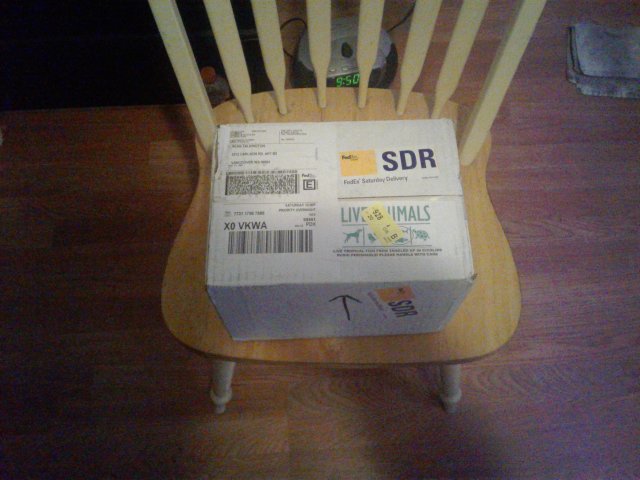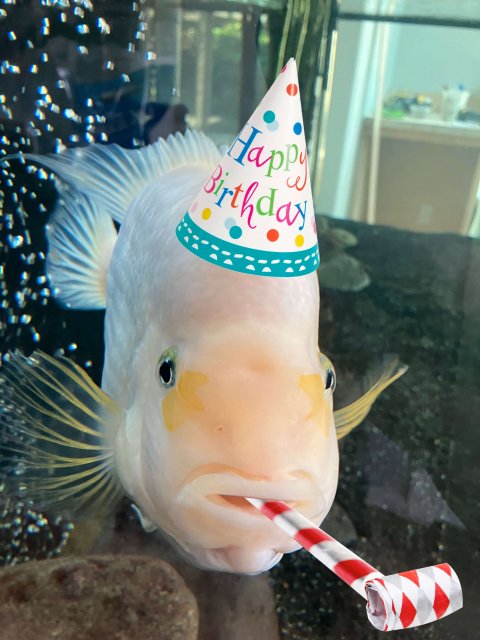My Amphilophus Sagittae journal
- Thread starter Jexnell
- Start date
-
- Tags
- amphilophus sagittae
You are using an out of date browser. It may not display this or other websites correctly.
You should upgrade or use an alternative browser.
You should upgrade or use an alternative browser.
Hello again all,
I wanted to provide another update on our friend Casper. We're getting along well...for the most part.
I've been doing some work on his tank which he has not been happy about, but I like to think he'll thank me. I made the mistake of doing the bulk of the work this past Sunday, which is his day to fast, so he was especially cranky with me that I was all around his tank and didn't once drop food in. He's normally pretty chill when I do water changes and just hangs out in his net (I still can't believe he does that), but whenever I put my hands in the tank to move stuff around this weekend, he was actively trying to attack me.
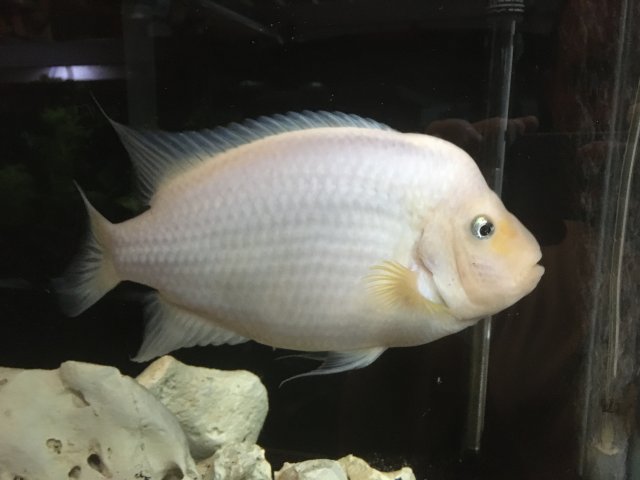
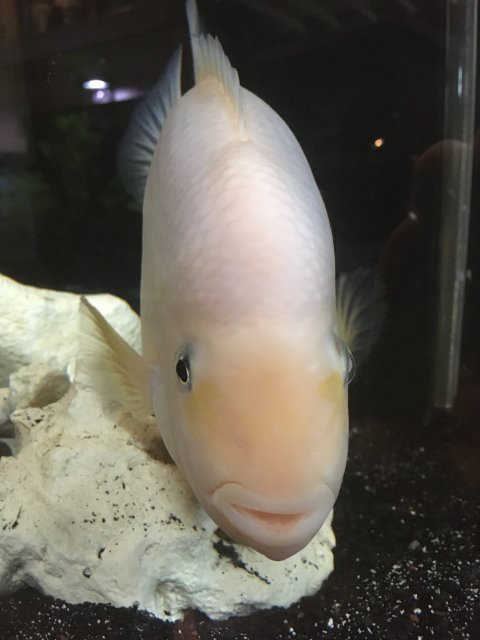
"You put your hand in here again, you're pulling back a stump"
As far as the work I've been doing on his tank...
In all my other tanks, I use a lot of live plants to help filter the water and suck out excess nutrients. With Casper and his tendency to eat pretty much anything that goes into his tank, it's not really an option. So, I had an idea to build a kind of sump system where I could house nitrate-sucking plants in a separate tank so they could filter the water without getting ripped apart.
So, let's see how this works...
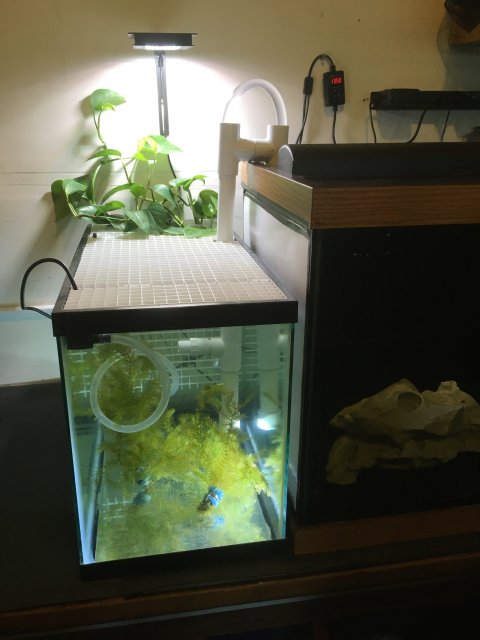
Of all the "iums" in this hobby to keep track of, I think this most closely resembles a refugium, which is apparently fairly common in the saltwater world, but mostly used for culturing worms and such in freshwater and avoid them getting eaten right away.
I've broken down my 20 gallon quarantine/grow out and and put it next to Casper's 125. For the overflow, I watched a lot of YouTube videos on an overflow system and the one I ended up building out of PVC isn't exactly like any of them, but it probably most closely resembles the one from Blake's Aquatics. I didn't want to limit the flow too much, so I used 1 1/4" PVC and 5/8" ID vinyl tubing across the top. I ended up putting a 90 degree elbow on the inlet to keep the water level up a little higher and above the bottom of the frame.
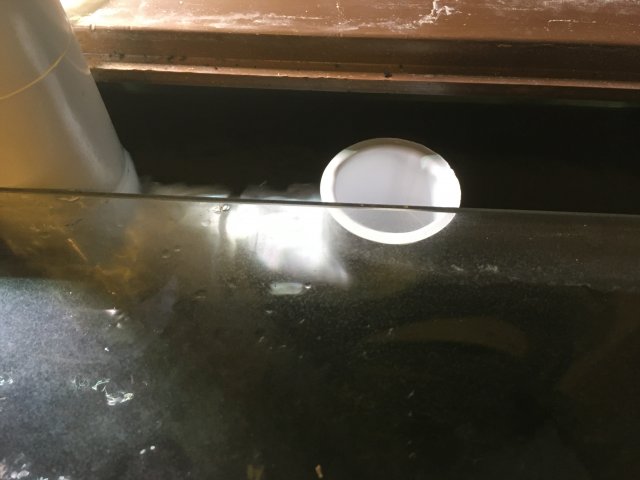
I had originally had the idea of using a spare powerhead to move water out of the small tank and into the big one, bu that didn't really work, since that's really not what they're designed to do, so I end up getting a (what turned out to be very small) submersible pump from Amazon. It's much smaller than I thought it would be, but so far seems to be doing the job. It's connected with 3/8" ID vinyl tubing that runs to the opposite side of the big tank, up into an old canister filter outlet tube. The pump is only about 95 GPH, so it's definitely not blasting water out of there, but it's enough.
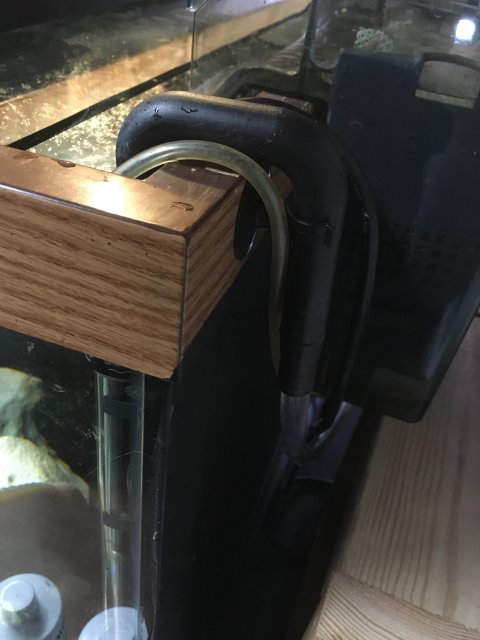
I've tried to set it up so that if either the pump fails or my overflow loses the siphon, things won't get flooded. Unless Casper somehow hulks the elbow off of the overflow (unlikely), there shouldn't be enough water to flood the 20 gallon and I've placed the pump pretty much as high as I can in the 20 gallon, so that if the overflow loses siphon, it would only pump an additional gallon or two into the big tank, which shouldn't be enough to make it over the lip. I guess that's the advantage to such a small pump. I am a little worried about the lack of water movement in the 20 gallon, since the flow is so low though, so maybe I'll add a spare sponge filter or air stone or the original power head in there just to get some water movement.
For nitrate, sucking plants, it seemed like hornwort and Amazon frog bit were some of the better options and I was thankfully able to find some locally (Shout out to World of Wet Pets in Beaverton--I just wish they were closer to me). I figured I'd start out small considering how quickly they are both said to propagate. I've covered the top with that plastic light diffuser grid from Home Depot (how versatile is that stuff in fishkeeping, btw???) and then put some pothos clippings from a friend of mine through that so the roots are in the water. Someone also recommended that I try sprouting a sweet potato in the water as well, so I plan to give that a shot.
I've mounted a Fluval Plant Nano above the pothos and I have a spare 18" Current USA LED that I can either put on top of the grid or slip down between the two tanks if the frog bit goes crazy to make sure the hornwort gets some light. Both are on timers for about 8 hours a day.
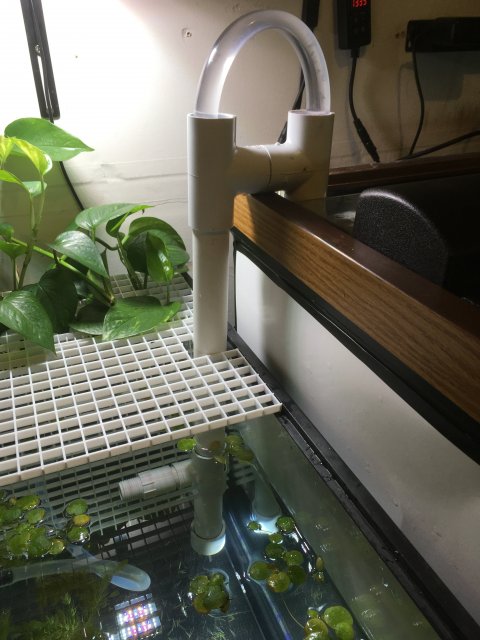
It's too soon to tell how good of a job this setup will do at removing nitrates, but it seems promising so far. Casper seems cool with it so far. It's far enough away from his pit that he doesn't get too grumpy about it. I've been pretty impressed with how well the overflow works, though. For an initial test, I set it up in my 75 gallon grow out tank that's across from this one. I threaded a garden hose onto the outlet and used it as an overflow to do probably about a 40-50% water change. It was able to handle the flow that comes out of my faucet, so I'm confident it will handle the tiny pump that's in there now. It was a little nerve-wracking watching my baby platies "investigate" the open overflow, but as far as I could tell, nobody actually got sucked out. So if this experiment fails miserably for some reason, at least I've built a pretty nifty way to handle a simple water change on larger tanks...
I wanted to provide another update on our friend Casper. We're getting along well...for the most part.
I've been doing some work on his tank which he has not been happy about, but I like to think he'll thank me. I made the mistake of doing the bulk of the work this past Sunday, which is his day to fast, so he was especially cranky with me that I was all around his tank and didn't once drop food in. He's normally pretty chill when I do water changes and just hangs out in his net (I still can't believe he does that), but whenever I put my hands in the tank to move stuff around this weekend, he was actively trying to attack me.


"You put your hand in here again, you're pulling back a stump"
As far as the work I've been doing on his tank...
In all my other tanks, I use a lot of live plants to help filter the water and suck out excess nutrients. With Casper and his tendency to eat pretty much anything that goes into his tank, it's not really an option. So, I had an idea to build a kind of sump system where I could house nitrate-sucking plants in a separate tank so they could filter the water without getting ripped apart.
So, let's see how this works...

Of all the "iums" in this hobby to keep track of, I think this most closely resembles a refugium, which is apparently fairly common in the saltwater world, but mostly used for culturing worms and such in freshwater and avoid them getting eaten right away.
I've broken down my 20 gallon quarantine/grow out and and put it next to Casper's 125. For the overflow, I watched a lot of YouTube videos on an overflow system and the one I ended up building out of PVC isn't exactly like any of them, but it probably most closely resembles the one from Blake's Aquatics. I didn't want to limit the flow too much, so I used 1 1/4" PVC and 5/8" ID vinyl tubing across the top. I ended up putting a 90 degree elbow on the inlet to keep the water level up a little higher and above the bottom of the frame.

I had originally had the idea of using a spare powerhead to move water out of the small tank and into the big one, bu that didn't really work, since that's really not what they're designed to do, so I end up getting a (what turned out to be very small) submersible pump from Amazon. It's much smaller than I thought it would be, but so far seems to be doing the job. It's connected with 3/8" ID vinyl tubing that runs to the opposite side of the big tank, up into an old canister filter outlet tube. The pump is only about 95 GPH, so it's definitely not blasting water out of there, but it's enough.

I've tried to set it up so that if either the pump fails or my overflow loses the siphon, things won't get flooded. Unless Casper somehow hulks the elbow off of the overflow (unlikely), there shouldn't be enough water to flood the 20 gallon and I've placed the pump pretty much as high as I can in the 20 gallon, so that if the overflow loses siphon, it would only pump an additional gallon or two into the big tank, which shouldn't be enough to make it over the lip. I guess that's the advantage to such a small pump. I am a little worried about the lack of water movement in the 20 gallon, since the flow is so low though, so maybe I'll add a spare sponge filter or air stone or the original power head in there just to get some water movement.
For nitrate, sucking plants, it seemed like hornwort and Amazon frog bit were some of the better options and I was thankfully able to find some locally (Shout out to World of Wet Pets in Beaverton--I just wish they were closer to me). I figured I'd start out small considering how quickly they are both said to propagate. I've covered the top with that plastic light diffuser grid from Home Depot (how versatile is that stuff in fishkeeping, btw???) and then put some pothos clippings from a friend of mine through that so the roots are in the water. Someone also recommended that I try sprouting a sweet potato in the water as well, so I plan to give that a shot.
I've mounted a Fluval Plant Nano above the pothos and I have a spare 18" Current USA LED that I can either put on top of the grid or slip down between the two tanks if the frog bit goes crazy to make sure the hornwort gets some light. Both are on timers for about 8 hours a day.

It's too soon to tell how good of a job this setup will do at removing nitrates, but it seems promising so far. Casper seems cool with it so far. It's far enough away from his pit that he doesn't get too grumpy about it. I've been pretty impressed with how well the overflow works, though. For an initial test, I set it up in my 75 gallon grow out tank that's across from this one. I threaded a garden hose onto the outlet and used it as an overflow to do probably about a 40-50% water change. It was able to handle the flow that comes out of my faucet, so I'm confident it will handle the tiny pump that's in there now. It was a little nerve-wracking watching my baby platies "investigate" the open overflow, but as far as I could tell, nobody actually got sucked out. So if this experiment fails miserably for some reason, at least I've built a pretty nifty way to handle a simple water change on larger tanks...
Casper update!
It's obviously been awhile since I've provided an update on our boy, Casper. What can I say? It's been a busy few months.
The biggest news of all perhaps is that Casper has since been moved inside! I was a little nervous over the winter about the temperature in the garage and since he's such a sociable fish, I thought it was high time to get him inside:
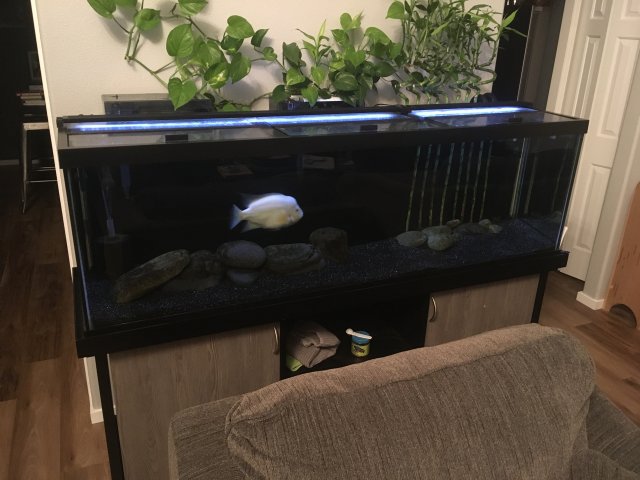
I got him a new (used) tank and put him along a wall in our front living room so he's the first thing you see when you come in the front door. Moving him is always an adventure, but after nearly hurting himself in the temporary garage tank that I put him into because he was freaking out so much and splashing water all over the freshly-painted wall behind this tank, he's finally in a more permanent place.
I like to think he's happier here than in the garage. He comes to greet my wife every morning when she gets up to make coffee and chases my kids back and forth as they play Nerf basketball on a hoop that hangs of a closet door that's off to the left out of frame.
I kind of abandoned the "refugium" idea when I moved him inside. I obviously had to change the setup of the tank where the plants were kept because they could no longer go directly next to the main tank. The space under the stand is frustratingly small, so the only thing that I could fit underneath was a 10 gallon, which I did end up doing for awhile. But with the way the overflow worked, I wasn't able to keep much water in the 10 gallon because if the power went out or my pump stopped, I had to have enough space so as to not over flow the 10 gallon, which for a 125 gallon tank, is kind of a lot of space, so I only ended up with about 5 gallons of usable water volume underneath.
And lifting the water that much higher meant a bigger pump and I had a hard time finding one that wasn't really noisy. This one wasn't too bad, but still definitely noticeable. The overflow itself was also really noisy and kind of sounded like somebody peeing into a drainpipe all the time. I probably could have messed around with it to quiet it down, but it was pretty clear from the start that the idea was no longer a viable option once moved indoors, so I didn't spend too much time messing with it before scrapping the idea. It seemed to work well and the plants grew like crazy, but there we just too many potential points of failure for me to be comfortable with it in my living room. I'd say it could definitely work with a more traditional sump system where the tank is drilled and the sump is bigger.
Instead, I've opted for some pothos stuck in an empty (but running) AquaClear 110 and some real big pieces of lucky bamboo, both of which have been know to process nitrates pretty well. They seem to be doing a decent job and have definitely grown a lot (the pothos is the same one that I was using initially). For whatever reason, Casper would dig up the piece of bamboo on the left and I would often find it sitting askew when I came down in the morning, so that's why there's now a pile of rocks in front of the stems. The room gets a fair amount of sun, but algae hasn't really been as big of an issue as I thought it would be. Mostly just brown diatoms that can be easily scrubbed off, or....
...I could leave it for food for Casper's new friends! My local fish store had what were labeled as "XL Mystery Snails" and boy, are they. These suckers are big. A good 2-2.5" in diameter. Definitely bigger than any snails I've ever seen.
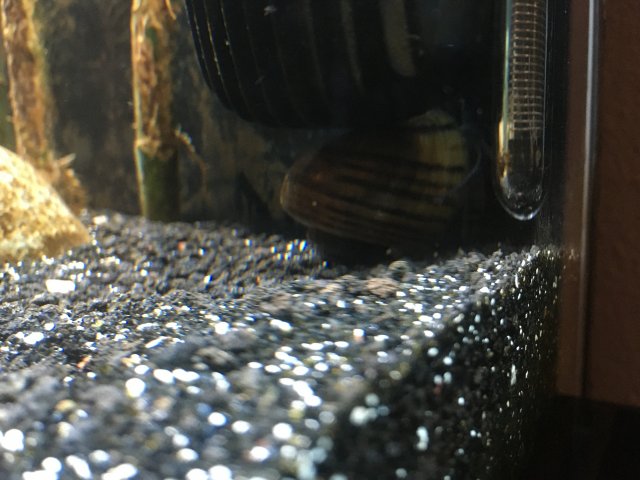
They're somewhat hard to take a picture of and it's amazing how easy it is for 2 giant snails to hide in such a sparsely-decorated tank, but they find a way. Casper photobombing doesn't help either...
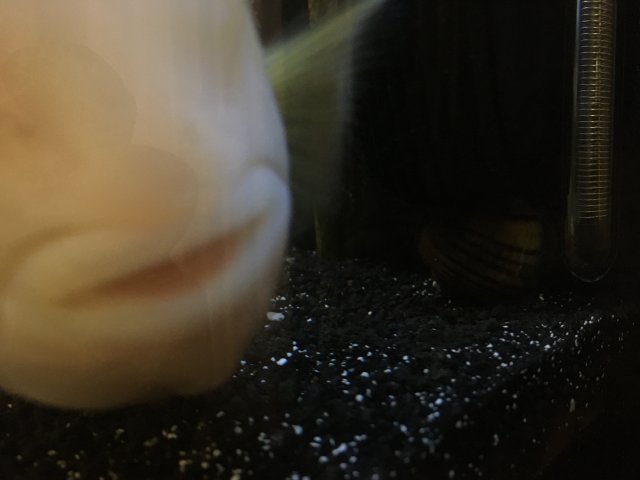
They're pretty neat, though. And, so far (knock on wood), Casper seems cool with them. When I initially put them in there, I sectioned off a portion of the tank with that white egg crate diffuser stuff for about a day, rearranged his rocks and threw a bit fake plant in there to distract him a bit. Eventually I took down the barrier and let him check things out. He kind of nipped at one of them initially, but that was pretty much the end of it.
I had also put a mid-sized bristlenose pleco in there as well, just to "test the waters", but Capser seemed a little too interested in her, so I pulled her out after a few hours. Too bad. A couple brislenose would have made short work of the algae growing on the rocks. I'd love to a a herd of nerite snails in there too, but they might be a little too bite-sized...
As my grandmother would say before hanging up on us, "That's all I know." It's been awhile, so I wanted to provide Jexnell
and anyone still following this thread an update on how things are going. And of course, to provide some glamour shots. Stay fishy, friends.
Jexnell
and anyone still following this thread an update on how things are going. And of course, to provide some glamour shots. Stay fishy, friends.
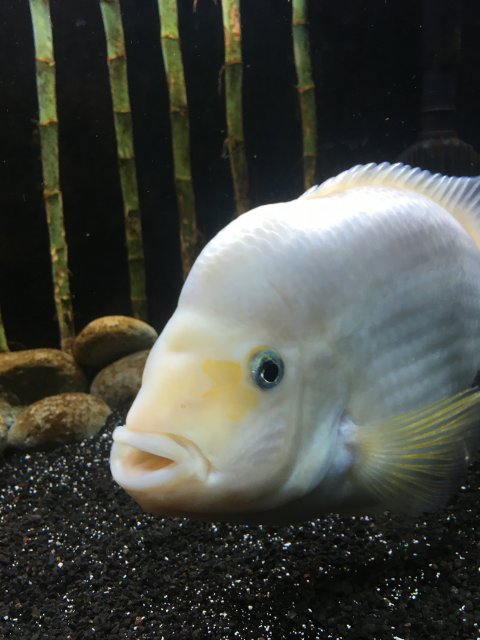
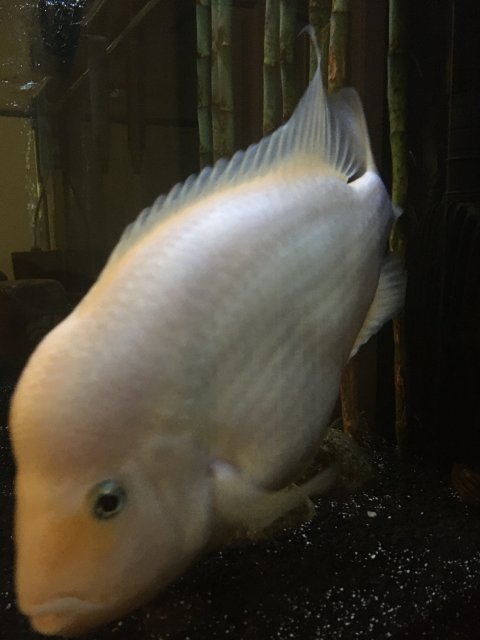
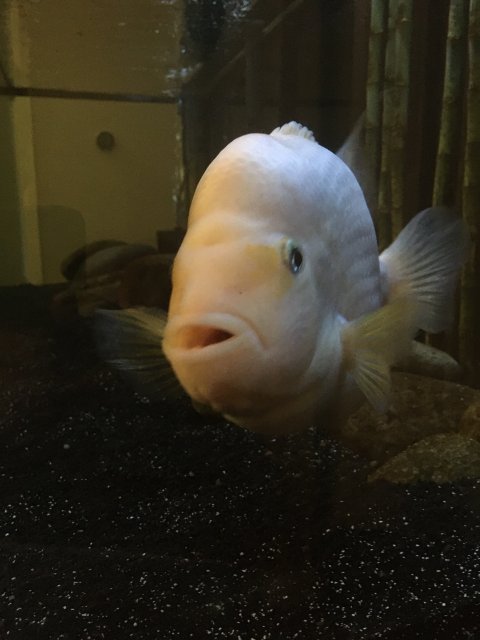
It's obviously been awhile since I've provided an update on our boy, Casper. What can I say? It's been a busy few months.
The biggest news of all perhaps is that Casper has since been moved inside! I was a little nervous over the winter about the temperature in the garage and since he's such a sociable fish, I thought it was high time to get him inside:

I got him a new (used) tank and put him along a wall in our front living room so he's the first thing you see when you come in the front door. Moving him is always an adventure, but after nearly hurting himself in the temporary garage tank that I put him into because he was freaking out so much and splashing water all over the freshly-painted wall behind this tank, he's finally in a more permanent place.
I like to think he's happier here than in the garage. He comes to greet my wife every morning when she gets up to make coffee and chases my kids back and forth as they play Nerf basketball on a hoop that hangs of a closet door that's off to the left out of frame.
I kind of abandoned the "refugium" idea when I moved him inside. I obviously had to change the setup of the tank where the plants were kept because they could no longer go directly next to the main tank. The space under the stand is frustratingly small, so the only thing that I could fit underneath was a 10 gallon, which I did end up doing for awhile. But with the way the overflow worked, I wasn't able to keep much water in the 10 gallon because if the power went out or my pump stopped, I had to have enough space so as to not over flow the 10 gallon, which for a 125 gallon tank, is kind of a lot of space, so I only ended up with about 5 gallons of usable water volume underneath.
And lifting the water that much higher meant a bigger pump and I had a hard time finding one that wasn't really noisy. This one wasn't too bad, but still definitely noticeable. The overflow itself was also really noisy and kind of sounded like somebody peeing into a drainpipe all the time. I probably could have messed around with it to quiet it down, but it was pretty clear from the start that the idea was no longer a viable option once moved indoors, so I didn't spend too much time messing with it before scrapping the idea. It seemed to work well and the plants grew like crazy, but there we just too many potential points of failure for me to be comfortable with it in my living room. I'd say it could definitely work with a more traditional sump system where the tank is drilled and the sump is bigger.
Instead, I've opted for some pothos stuck in an empty (but running) AquaClear 110 and some real big pieces of lucky bamboo, both of which have been know to process nitrates pretty well. They seem to be doing a decent job and have definitely grown a lot (the pothos is the same one that I was using initially). For whatever reason, Casper would dig up the piece of bamboo on the left and I would often find it sitting askew when I came down in the morning, so that's why there's now a pile of rocks in front of the stems. The room gets a fair amount of sun, but algae hasn't really been as big of an issue as I thought it would be. Mostly just brown diatoms that can be easily scrubbed off, or....
...I could leave it for food for Casper's new friends! My local fish store had what were labeled as "XL Mystery Snails" and boy, are they. These suckers are big. A good 2-2.5" in diameter. Definitely bigger than any snails I've ever seen.

They're somewhat hard to take a picture of and it's amazing how easy it is for 2 giant snails to hide in such a sparsely-decorated tank, but they find a way. Casper photobombing doesn't help either...

They're pretty neat, though. And, so far (knock on wood), Casper seems cool with them. When I initially put them in there, I sectioned off a portion of the tank with that white egg crate diffuser stuff for about a day, rearranged his rocks and threw a bit fake plant in there to distract him a bit. Eventually I took down the barrier and let him check things out. He kind of nipped at one of them initially, but that was pretty much the end of it.
I had also put a mid-sized bristlenose pleco in there as well, just to "test the waters", but Capser seemed a little too interested in her, so I pulled her out after a few hours. Too bad. A couple brislenose would have made short work of the algae growing on the rocks. I'd love to a a herd of nerite snails in there too, but they might be a little too bite-sized...
As my grandmother would say before hanging up on us, "That's all I know." It's been awhile, so I wanted to provide



Casper loves back and forth games. We had two different ones.
First one is the obvious sliding your finger along the front glass side to side.
The second one is place a finger on the side glass. He will swim over with a full head of steam, and slam on the breaks just in time to not slam his face into the glass. Then proceed to try and bite the offending finger. Rinse and repeat end for end till he gets bored and goes and digs in your nicely manicured sand....lol
First one is the obvious sliding your finger along the front glass side to side.
The second one is place a finger on the side glass. He will swim over with a full head of steam, and slam on the breaks just in time to not slam his face into the glass. Then proceed to try and bite the offending finger. Rinse and repeat end for end till he gets bored and goes and digs in your nicely manicured sand....lol
He's not much bigger than when I first got him from
 Jexnell
. I'd say probably around 12 inches. He's a few more pictures that might show his size a bit better He's still in his 125)
Jexnell
. I'd say probably around 12 inches. He's a few more pictures that might show his size a bit better He's still in his 125)
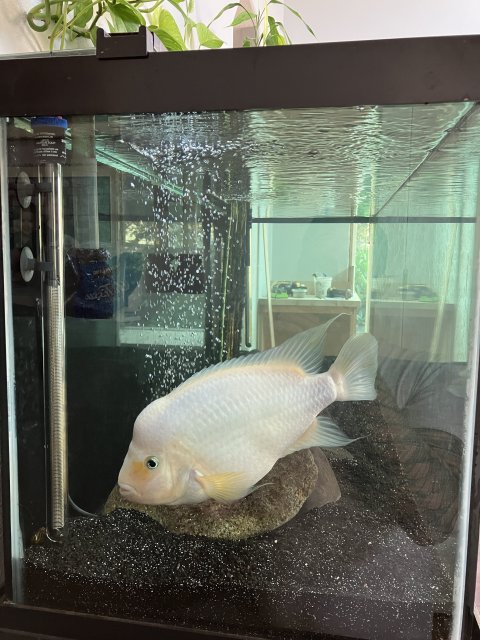
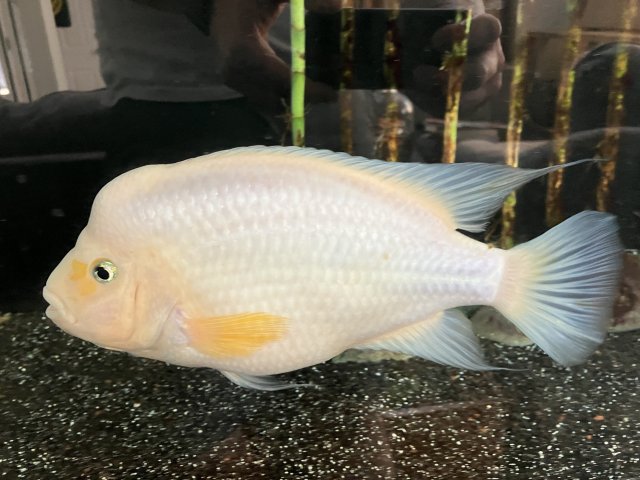


He is as stunning as ever!
I may be wrong in this, but I believe that since Saggitae are open water fish, that they may not bulk out as much as Midas or Devils do. They are more of an athletic build like a Greyhound vs a Rottweiler.
I may be wrong in this, but I believe that since Saggitae are open water fish, that they may not bulk out as much as Midas or Devils do. They are more of an athletic build like a Greyhound vs a Rottweiler.


